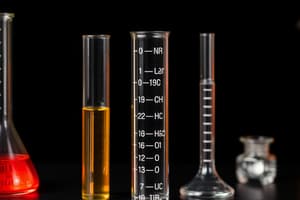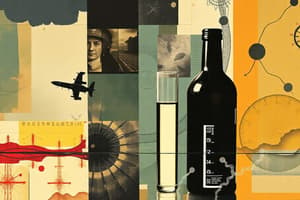Podcast
Questions and Answers
Which of the following factors can affect the speed of a chemical reaction?
Which of the following factors can affect the speed of a chemical reaction?
- Particle size
- Concentration
- Temperature
- All of the above (correct)
Enzymes are inorganic catalysts.
Enzymes are inorganic catalysts.
False (B)
What is a catalyst?
What is a catalyst?
A substance that increases the speed of a chemical reaction without being consumed in the process.
The total volume of gas produced in a reaction will ___________ as the reaction proceeds.
The total volume of gas produced in a reaction will ___________ as the reaction proceeds.
Match the following methods of measuring reaction speed with their corresponding descriptions:
Match the following methods of measuring reaction speed with their corresponding descriptions:
What does the gradient of a volume of gas evolved against time graph indicate?
What does the gradient of a volume of gas evolved against time graph indicate?
The speed of reaction remains constant throughout the entire process.
The speed of reaction remains constant throughout the entire process.
At what time does the gradient of the mass against time graph become zero?
At what time does the gradient of the mass against time graph become zero?
The speed of reaction decreases as the reactants are _________.
The speed of reaction decreases as the reactants are _________.
Match the following statements regarding the reaction's progress:
Match the following statements regarding the reaction's progress:
What happens to the amount of gas produced over time during the reaction?
What happens to the amount of gas produced over time during the reaction?
The apparatus can measure both volume of gas evolved and mass of the reaction mixture.
The apparatus can measure both volume of gas evolved and mass of the reaction mixture.
What does a horizontal line on the volume of gas evolved against time graph represent?
What does a horizontal line on the volume of gas evolved against time graph represent?
Which of the following factors does NOT affect the speed of a chemical reaction?
Which of the following factors does NOT affect the speed of a chemical reaction?
The more reactant particles collide, the slower the reaction will be.
The more reactant particles collide, the slower the reaction will be.
What is the term used to describe the minimum energy required for a reaction to occur?
What is the term used to describe the minimum energy required for a reaction to occur?
The total volume of gas evolved during the reaction was _____ cm3.
The total volume of gas evolved during the reaction was _____ cm3.
Match the following factors with their effects on the speed of a reaction:
Match the following factors with their effects on the speed of a reaction:
What is the expected outcome of increasing the temperature of reactants?
What is the expected outcome of increasing the temperature of reactants?
Why is a catalyst used in chemical reactions?
Why is a catalyst used in chemical reactions?
A fast reaction will always produce a larger volume of gas compared to a slow reaction under the same conditions.
A fast reaction will always produce a larger volume of gas compared to a slow reaction under the same conditions.
Which factor contributes to an increased speed of reaction due to a larger surface area?
Which factor contributes to an increased speed of reaction due to a larger surface area?
Increasing the pressure of a gas decreases the speed of a chemical reaction.
Increasing the pressure of a gas decreases the speed of a chemical reaction.
What happens to the speed of reaction when the temperature increases?
What happens to the speed of reaction when the temperature increases?
The Haber process operates at high pressure of _____ atm.
The Haber process operates at high pressure of _____ atm.
What is the main reason for the increase in reaction speed when particle size decreases?
What is the main reason for the increase in reaction speed when particle size decreases?
Smaller reactant particles lead to a decrease in the frequency of effective collisions.
Smaller reactant particles lead to a decrease in the frequency of effective collisions.
Name one factor that increases the speed of a chemical reaction.
Name one factor that increases the speed of a chemical reaction.
What is the primary function of a catalyst in a chemical reaction?
What is the primary function of a catalyst in a chemical reaction?
Enzymes can function effectively only within a wide range of pH levels.
Enzymes can function effectively only within a wide range of pH levels.
What term is used for substances that prevent catalysts from functioning effectively?
What term is used for substances that prevent catalysts from functioning effectively?
A catalyst provides an alternative pathway with a lower _________ energy for the reaction to proceed.
A catalyst provides an alternative pathway with a lower _________ energy for the reaction to proceed.
Match the following characteristics with the correct statements:
Match the following characteristics with the correct statements:
What effect does an enzyme have on a reaction?
What effect does an enzyme have on a reaction?
All catalysts are transition metals or their compounds.
All catalysts are transition metals or their compounds.
Enzymes generally double the rate of reaction for every _______ degree Celsius increase in temperature until denaturation occurs.
Enzymes generally double the rate of reaction for every _______ degree Celsius increase in temperature until denaturation occurs.
Flashcards
Reaction Rate
Reaction Rate
The speed at which a chemical reaction occurs.
Measuring Reaction Rate
Measuring Reaction Rate
The rate of reaction is measured by the amount of reactant used up or the amount of product formed in a given time.
Factors Affecting Reaction Rate
Factors Affecting Reaction Rate
Factors that affect the speed of a reaction, such as temperature, concentration, surface area and catalysts.
Catalyst
Catalyst
Signup and view all the flashcards
Enzymes
Enzymes
Signup and view all the flashcards
Gradient
Gradient
Signup and view all the flashcards
Speed of Reaction
Speed of Reaction
Signup and view all the flashcards
Start of Reaction
Start of Reaction
Signup and view all the flashcards
As Reaction Proceeds
As Reaction Proceeds
Signup and view all the flashcards
Reaction Ends
Reaction Ends
Signup and view all the flashcards
Volume of Gas vs. Time Graph
Volume of Gas vs. Time Graph
Signup and view all the flashcards
Mass vs. Time Graph
Mass vs. Time Graph
Signup and view all the flashcards
Change in Mass
Change in Mass
Signup and view all the flashcards
Activation Energy
Activation Energy
Signup and view all the flashcards
Collision Theory
Collision Theory
Signup and view all the flashcards
Effect of Concentration on Reaction Rate
Effect of Concentration on Reaction Rate
Signup and view all the flashcards
Effect of Temperature on Reaction Rate
Effect of Temperature on Reaction Rate
Signup and view all the flashcards
Volume of Gas Evolved
Volume of Gas Evolved
Signup and view all the flashcards
How does particle size affect reaction rate?
How does particle size affect reaction rate?
Signup and view all the flashcards
How does pressure affect reaction rate?
How does pressure affect reaction rate?
Signup and view all the flashcards
How does temperature affect reaction rate?
How does temperature affect reaction rate?
Signup and view all the flashcards
What is activation energy?
What is activation energy?
Signup and view all the flashcards
Why is pressure only relevant for reactions involving gases?
Why is pressure only relevant for reactions involving gases?
Signup and view all the flashcards
How does the Haber process illustrate pressure's effect on reaction rate?
How does the Haber process illustrate pressure's effect on reaction rate?
Signup and view all the flashcards
What is the marble and acid reaction?
What is the marble and acid reaction?
Signup and view all the flashcards
How does the size of marble affect the reaction rate with acid?
How does the size of marble affect the reaction rate with acid?
Signup and view all the flashcards
How Catalysts Work
How Catalysts Work
Signup and view all the flashcards
Substrate
Substrate
Signup and view all the flashcards
Enzyme Specificity
Enzyme Specificity
Signup and view all the flashcards
Temperature and Enzyme Activity
Temperature and Enzyme Activity
Signup and view all the flashcards
pH and Enzyme Activity
pH and Enzyme Activity
Signup and view all the flashcards
Study Notes
Speed of Reaction
- Reactions proceed at different rates, ranging from very fast (explosions) to very slow (rusting).
- Methods to measure reaction rate include measuring product formation, reactant consumption, or changes during the reaction over time.
Measuring Reaction Rate
- Reaction rate can be measured by monitoring the volume of gas produced (e.g., using a gas syringe) or the mass loss (e.g., using a balance) over time.
- Data collected can be plotted as graphs (volume/mass vs. time)
- The gradient of the graph represents the reaction rate (steeper gradient = faster reaction).
Factors Affecting Reaction Rates
- Particle Size: Smaller particles have a larger surface area, leading to more frequent collisions and faster reactions.
- Concentration: Higher concentration means more particles per unit volume, increasing collision frequency and reaction rate.
- Temperature: Higher temperatures provide particles with more kinetic energy, leading to more frequent and energetic collisions. Increasing temperature generally doubles reaction rate with every 10°C increase.
- Pressure: Increasing pressure for gaseous reactants increases the concentration, increasing the frequency of collisions.
- Catalysts: Catalysts speed up reactions by providing an alternative reaction pathway with lower activation energy. Catalysts are unchanged after the reaction.
- Enzymes: Enzymes are biological catalysts that work by lowering activation energy, speeding up biochemical reactions. Their activity is affected by temperature and pH.
Collision Theory
- Reactions only occur when reacting particles collide with sufficient energy (activation energy).
- The more collisions per unit time and the more energetic the collisions, the faster the reaction.
- Collision theory explains how factors such as concentration, temperature, and particle size affect reaction rates.
Studying That Suits You
Use AI to generate personalized quizzes and flashcards to suit your learning preferences.



